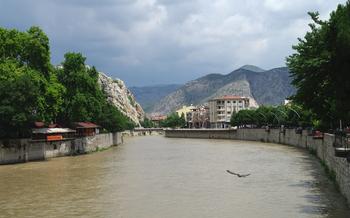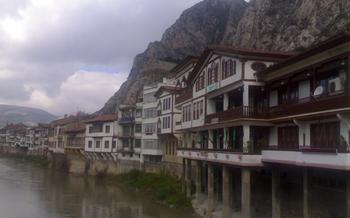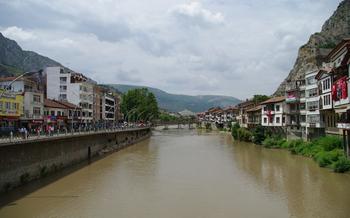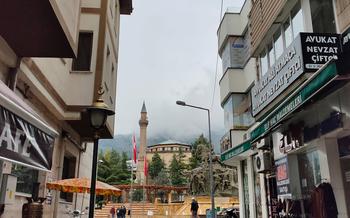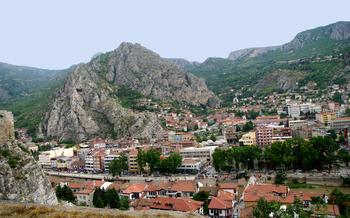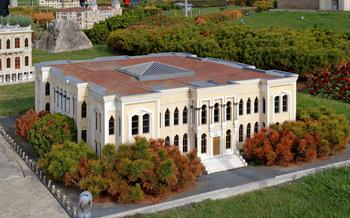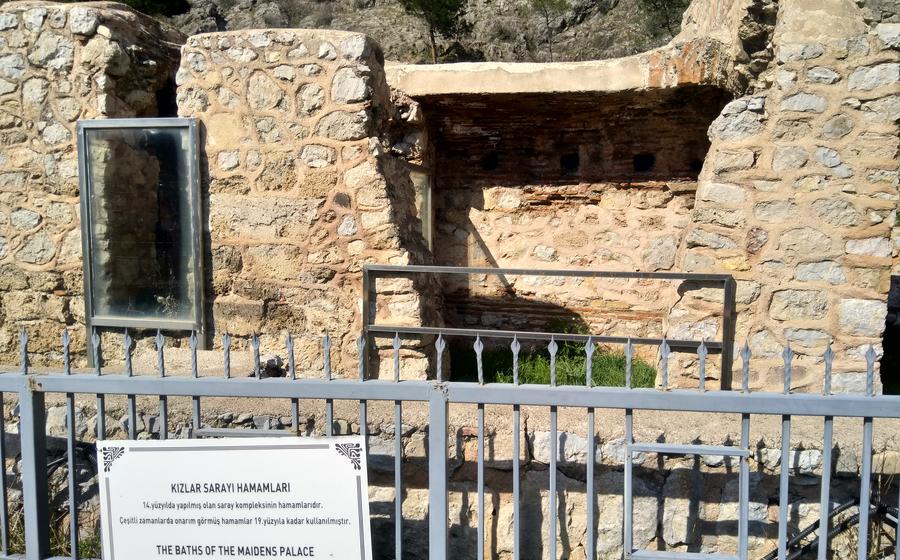
Amasya Turkish Bath Museum
- A Trip to the Past: Unveiling the History of Amasya Turkish Bath Museum
- Indulge in Tranquility: An Overview of the Museum's Ambiance
- Unraveling the Layers: Exploring the Museum's Layout
- Echoes of Tradition: Discovering the Rituals of a Turkish Bath
- Architectural Masterpiece: Marveling at the Museum's Design
- A Journey Through Time: Tracing the Evolution of Bathing Culture
- A Canvas of Art: Admire the Museum's Artistic Treasures
- Beyond Bathing: Exploring Amasya's Cultural Tapestry
- A Glimpse into Local Life: Interacting with the Museum's Staff
- Capture the Moment: Photography and Videography Guidelines
- Practical Information: Planning Your Visit
- Accessorize Your Experience: Essential Items to Bring
- Local Delights: Exploring Amasya's Culinary Scene
- Insider Tip: Unveiling the Secret Gem
A Trip to the Past: Unveiling the History of Amasya Turkish Bath Museum
In the heart of Amasya, a city steeped in history and natural beauty, stands a testament to the ancient tradition of bathing—the Amasya Turkish Bath Museum. This meticulously preserved bathhouse, dating back to the 14th century, offers visitors a unique opportunity to immerse themselves in the rich cultural heritage of Turkey's bathing rituals.
Originally commissioned by the Seljuk Sultan, the bathhouse served as a communal space for cleansing, relaxation, and social interaction. Over the centuries, it underwent various renovations and expansions, reflecting the changing architectural styles and evolving bathing practices of the Ottoman Empire. In the 1970s, the bathhouse was carefully restored and transformed into a museum, allowing visitors to step back in time and experience the ambiance of a traditional Turkish bath.
The Amasya Turkish Bath Museum stands as a testament to the enduring legacy of Turkish bathing culture. With its intricate architectural details, serene ambiance, and immersive exhibits, it invites visitors to embark on a journey of discovery, unveiling the history, rituals, and cultural significance of this ancient tradition.
Indulge in Tranquility: An Overview of the Museum's Ambiance
Step into the Amasya Turkish Bath Museum and be transported to a realm of serenity and tranquility. The moment you cross the threshold, a sense of calm envelops you, inviting you to leave behind the stresses of the outside world. The air is infused with a delicate aroma of essential oils, and the gentle sound of water trickling from the fountains creates a soothing ambiance.
The museum faithfully recreates the layout and atmosphere of a traditional Turkish bathhouse, allowing visitors to experience the centuries-old bathing rituals that have been an integral part of Turkish culture. The warm, inviting interiors feature intricate tilework, marble columns, and domed ceilings, creating a visually stunning and immersive environment.
As you wander through the various chambers of the bathhouse, you'll discover hot rooms, cold rooms, and relaxation areas, each designed to provide a unique and revitalizing experience. The hot room, with its steamy atmosphere, encourages deep relaxation and detoxification, while the cold room offers a refreshing contrast, invigorating the senses and promoting circulation.
The museum's ambiance is not merely a product of its physical features but also stems from the deep respect for tradition that permeates every aspect of the experience. Visitors are encouraged to immerse themselves in the bathing rituals, donning traditional peshtemals (bath towels) and indulging in the kese, sabun, and lif (exfoliating mitt, soap, and loofah) treatments that have been passed down through generations.
Whether you seek a tranquil retreat or a glimpse into the rich bathing traditions of Turkey, the Amasya Turkish Bath Museum offers an unforgettable experience that will leave you feeling refreshed, rejuvenated, and deeply connected to the culture of this ancient land.
Unraveling the Layers: Exploring the Museum's Layout
The Amasya Turkish Bath Museum showcases a fascinating layout that reflects the traditional structure of a Turkish bathhouse. As visitors journey through the museum, they will encounter distinct sections and chambers, each serving a specific purpose in the bathing ritual.
The heart of the bathhouse is the hot room, known as the "sıcaklık." This chamber is characterized by its high temperatures and humid atmosphere, creating a steamy environment that helps to open pores and promote relaxation. The hot room features marble benches and platforms where bathers would recline and receive massages.
Adjacent to the hot room is the cold room, or "soğukluk." This chamber offers a stark contrast to the hot room, with its cool temperatures and refreshing ambiance. The cold room is often decorated with intricate tilework and features a central pool or fountain where bathers could cool off and rinse themselves.
Between the hot and cold rooms, visitors will find the relaxation area, or "camekan." This space serves as a transition zone, allowing bathers to gradually adjust to the temperature changes between the two chambers. The camekan is typically furnished with comfortable seating areas and often features decorative elements such as mirrors and wall paintings.
Beyond these main chambers, the museum also includes other functional spaces, such as changing rooms, restrooms, and a boiler room. These spaces provide a glimpse into the behind-the-scenes operations of the bathhouse and offer visitors a deeper understanding of its historical significance.
Echoes of Tradition: Discovering the Rituals of a Turkish Bath
The Amasya Turkish Bath Museum not only offers a glimpse into the history of bathing culture but also provides an opportunity to experience the traditional Turkish bath ritual. Step by step, visitors can immerse themselves in the centuries-old practice that has been an integral part of Turkish society for generations.
The process begins with the kese, a rough mitt used to exfoliate the skin, removing impurities and dead cells. This is followed by a thorough wash with sabun, a natural soap made from olive oil and lye, leaving the skin feeling clean and refreshed. The final step involves the lif, a loofah-like sponge, used to massage the body and stimulate circulation, promoting relaxation and well-being.
Beyond the physical benefits, the Turkish bath holds cultural significance as a place of social interaction and community bonding. Families and friends would gather in the bathhouses to socialize, relax, and share stories, fostering a sense of togetherness and camaraderie.
The Amasya Turkish Bath Museum offers visitors a chance to not only learn about the history of bathing practices but also to experience the rejuvenating and culturally significant ritual of a traditional Turkish bath, allowing them to connect with the local culture on a deeper level.
Architectural Masterpiece: Marveling at the Museum's Design
The Amasya Turkish Bath Museum is not just a place of relaxation and rejuvenation; it is also a testament to the architectural prowess of the Ottoman Empire. The bathhouse showcases a harmonious blend of traditional Turkish and Islamic design elements, creating a visually stunning masterpiece.
The exterior facade is characterized by its symmetry and simplicity, with clean lines and arched doorways. As you step inside, you'll be greeted by a spacious central chamber, adorned with intricate tilework and calligraphy inscriptions. The domed ceilings, supported by slender columns, allow natural light to filter in, creating a warm and inviting ambiance.
The use of local materials, such as marble and granite, adds to the authenticity and elegance of the museum. The attention to detail is evident in every corner, from the intricate carvings on the doorways to the colorful mosaics that adorn the walls. Each element contributes to the overall aesthetic, making the Amasya Turkish Bath Museum a true architectural gem.
The design of the museum not only serves an aesthetic purpose but also reflects the functional aspects of a traditional Turkish bath. The layout is carefully planned to ensure a smooth flow of bathers, with separate areas for hot, cold, and relaxation. The hot room, with its high ceilings and marble basins, is a testament to the importance of steam in the bathing ritual. The cold room, with its refreshing plunge pool, provides a contrast to the heat and helps to close the pores. The relaxation area, with its comfortable seating and soothing ambiance, invites visitors to unwind and savor the afterglow of their bathing experience.
A Journey Through Time: Tracing the Evolution of Bathing Culture
The Amasya Turkish Bath Museum offers a unique opportunity to delve into the rich history and evolution of bathing culture in Turkey. Bathing practices have been an integral part of Turkish society for centuries, serving not only as a means of cleanliness but also as a social and cultural ritual.
The museum's exhibits showcase the evolution of bathhouse design and technology, from simple communal baths in ancient times to the elaborate and luxurious bathhouses of the Ottoman Empire. Visitors can learn about the influence of different cultures and civilizations, such as the Romans and Byzantines, on Turkish bathing traditions.
The museum also highlights the continuity of bathing traditions throughout history. Despite the changes in design and technology, the fundamental principles of the Turkish bath experience remain the same: cleansing, relaxation, and rejuvenation. Visitors can gain a deeper understanding of the cultural significance of the bathhouse and its enduring role in Turkish society.
Exploring the Amasya Turkish Bath Museum is a journey through time, allowing visitors to trace the evolution of bathing culture in Turkey and appreciate the unique blend of history, architecture, and tradition that makes this museum a must-visit destination.
A Canvas of Art: Admire the Museum's Artistic Treasures
The Amasya Turkish Bath Museum is not just a place to cleanse the body but also a treasure trove of artistic wonders. Every nook and cranny of the museum is adorned with exquisite tilework, intricate mosaics, and vibrant paintings, each telling a unique story.
The walls of the museum are adorned with colorful tiles, each hand-painted with intricate designs and patterns. The tiles depict scenes from Turkish history, mythology, and everyday life, providing a glimpse into the rich cultural heritage of the region.
The ceilings of the museum are adorned with stunning mosaics, featuring geometric patterns, floral motifs, and calligraphy inscriptions. These mosaics are a testament to the skill and artistry of the craftsmen who created them, and they add a touch of grandeur to the museum's ambiance.
In addition to the tilework and mosaics, the museum also houses a collection of paintings that depict scenes from the history of the bathhouse and the surrounding city. These paintings offer a unique perspective on the lives of the people who frequented the bathhouse and provide a glimpse into the social and cultural history of Amasya.
The Amasya Turkish Bath Museum is a true feast for the eyes, and its artistic treasures are a testament to the creativity and artistry of the Turkish people. Visitors to the museum can spend hours admiring the intricate details and symbolism of the artwork, gaining a deeper appreciation for the cultural heritage of Turkey.
Beyond Bathing: Exploring Amasya's Cultural Tapestry
Amasya Turkish Bath Museum is not merely a historical monument; it is an integral part of the city's rich cultural tapestry. The bathhouse has been interwoven into the fabric of Amasya for centuries, serving as a place of not only cleansing but also social interaction and cultural exchange.
Beyond its primary function, the museum offers visitors a glimpse into Amasya's vibrant cultural heritage. The city boasts a long and storied history, dating back to ancient times. It was once the capital of the Pontic Kingdom and later served as an important center during the Roman, Byzantine, and Ottoman empires.
Amasya's cultural diversity is reflected in its festivals, traditions, and cuisine. Visitors to the city can immerse themselves in the local culture by attending traditional festivals such as the Amasya Cherry Festival or the Amasya International Music Festival. They can also explore the city's many historical sites, including the Amasya Castle, the Great Mosque, and the tombs of the Pontic kings.
Amasya's cuisine is another highlight, with dishes such as Amasya kebabı, keşkek, and höşmerim being must-tries. Visitors can savor these delicacies at local restaurants and cafes, many of which offer stunning views of the city and the Yeşilırmak River.
A visit to Amasya Turkish Bath Museum is not just about experiencing the history of bathing culture; it is also about exploring the city's rich cultural tapestry and immersing oneself in the local way of life.
A Glimpse into Local Life: Interacting with the Museum's Staff
The Amasya Turkish Bath Museum is not just a place to experience history and relaxation; it's also an opportunity to connect with the local community. The museum's staff is renowned for their friendliness and hospitality, and they are always eager to share their knowledge and stories with visitors.
Engage in conversations with the staff to learn about their experiences working at the museum, their insights into Turkish customs and traditions, and their recommendations for exploring Amasya. These interactions provide a glimpse into the local culture and allow visitors to build meaningful connections with the people who keep this historic institution alive.
Moreover, visitors can participate in cultural exchange by sharing their own experiences and perspectives. This reciprocal dialogue fosters mutual understanding and appreciation between visitors and locals, creating a richer and more fulfilling experience for all.
Capture the Moment: Photography and Videography Guidelines
The Amasya Turkish Bath Museum welcomes visitors to capture the essence and beauty of the establishment through photography and videography. However, to ensure a respectful and harmonious environment, certain guidelines and restrictions must be followed.
First and foremost, respecting the privacy of other visitors is of utmost importance. Avoid taking photos or videos that may invade someone's personal space or infringe on their right to privacy. It is advisable to ask for permission before capturing images of individuals, especially if they are engaged in private activities.
While capturing the ambiance and architectural features of the museum is encouraged, flash photography and the use of tripods are strictly prohibited. These can be disruptive to other visitors and can damage the delicate artifacts and artwork within the museum.
To ensure that everyone enjoys the museum experience, visitors are requested to keep their voices low and avoid talking excessively. This creates a serene atmosphere that allows all visitors to fully immerse themselves in the tranquility of the museum.
It is important to capture the essence and authenticity of the museum's ambiance. Avoid using filters or editing techniques that may alter the natural beauty and historical significance of the establishment.
By following these guidelines, visitors can not only document their experiences but also contribute to preserving the integrity and atmosphere of the Amasya Turkish Bath Museum for future generations.
Additionally, sharing experiences through visual storytelling is encouraged. Visitors are welcome to share their photos and videos on social media, tagging the museum and using relevant hashtags. This helps promote the museum and allows others to discover its beauty and historical significance.
Practical Information: Planning Your Visit
To ensure a smooth and enjoyable visit to the Amasya Turkish Bath Museum, it's essential to plan ahead.
Accessorize Your Experience: Essential Items to Bring
Packing for a trip to the Amasya Turkish Bath Museum requires a few essential items to ensure a smooth and enjoyable experience.
-
Swimsuit, towel, and slippers: These are essential for indulging in the traditional Turkish bath ritual. Choose comfortable and modest swimwear that respects local customs. Bring a large towel for drying off and a pair of slippers to protect your feet from the heated floors.
-
Personal toiletries and skincare products: Bring your favorite shampoo, conditioner, and soap, as well as any other personal care items you may need. Consider packing a gentle exfoliating scrub or mitt to enhance the cleansing process.
-
Camera or smartphone for capturing memories: The Amasya Turkish Bath Museum offers many photo-worthy moments. Bring your camera or smartphone to capture the stunning architecture, intricate details, and your own unique bathing experience.
-
Water bottle for hydration: Staying hydrated is important, especially in the warm and humid environment of the bathhouse. Bring a water bottle to stay refreshed and avoid dehydration.
-
Modest clothing for exploring the city after the bath: After your relaxing bath experience, you may want to explore the surrounding city of Amasya. Pack modest clothing that respects local customs, such as long skirts or pants and tops that cover your shoulders.
Local Delights: Exploring Amasya's Culinary Scene
A visit to the Amasya Turkish Bath Museum is not complete without savoring the culinary delights that Amasya has to offer. The city boasts a vibrant food scene, where traditional Turkish cuisine blends harmoniously with local specialties.
After a rejuvenating bath, indulge in a hearty meal at one of the many restaurants and cafes lining the picturesque streets of Amasya. For a truly authentic experience, try the local dish of "Amasya Çöreği", a flaky pastry filled with cheese or minced meat. "Amasya Elması" is another must-try, a sweet and juicy apple variety unique to the region.
To satisfy your sweet tooth, head to one of the traditional Turkish dessert shops and sample the delectable "baklava" or "künefe." These syrupy pastries, made with layers of filo dough and filled with nuts, are a testament to the culinary skills of Amasyan artisans.
When in Amasya, don't miss the opportunity to taste the freshly caught trout from the Yeşilırmak River. Grilled or fried, this local delicacy is a favorite among both locals and visitors.
As you explore the city's culinary scene, remember to strike a balance between indulgence and healthy choices. Amasya's cuisine offers a variety of fresh and nutritious options, such as salads, grilled vegetables, and yogurt-based dishes.
By combining the sensory delights of the Turkish bath with the culinary treasures of Amasya, you'll create a truly immersive and memorable experience that will leave you feeling refreshed, relaxed, and satisfied.
Insider Tip: Unveiling the Secret Gem
Beyond the main attractions, the Amasya Turkish Bath Museum holds hidden secrets waiting to be discovered. Explore the nooks and crannies of the building to uncover unique artifacts or historical anecdotes that bring the past to life. Ask the friendly staff for recommendations on off-the-beaten-path experiences that will give you a deeper understanding of the museum's significance. By venturing beyond the surface, you'll create a personalized and memorable visit that will leave you with a lasting appreciation for this cultural treasure.


